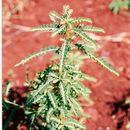Brief Summary
provided by IABIN
Diagnosis Species with considerable toe webbing and distinct black and/or white tubercles on the dorsum. Males 38-48 mm, females 44-54 mm snout-vent length. Lack distinct spots on the posterior surface of the thigh. The dorsal tubercles are borne on high relief warts.
- author
- Esteban O. Lavilla
- editor
- Diego Arrieta
Distribution
provided by IABIN
Serra do Mar in the State of Santa Catarina, Brazil.
- author
- Esteban O. Lavilla
- editor
- Diego Arrieta
Diagnostic Description
provided by IABIN
Adult morphology No thumb spines; snout profile rounded, blunt, or lip pronounced; dorsal pattern blotched to almost uniformly dark brown; posterior surf ace of thigh usually uniformly patterned, mottled to sometimes distinctly light spotted; no distinctive colors in life; dorsum with high relief warts bearing shagreen and black and/or white tubercles, warts sometimes aligned in irregular to regular lines; male foot web considerable. Male snout-vent length 44.3 mm maximum 47.8 mm, female snout-vent length 49.4, maximum 53.7 mm, females larger than males. Male head length/ snout-vent length ratio 0.39 ± .02; female 0.38 ± .01; male head width/ snout-vent length ratio 0.42 ± .02, female 0.42 ±.01; male eye-nostril distance/ snout-vent length ratio 0.09 ± .01, female 0.09 ± .01; male eye-eye distance snout-vent length ratio 0.19 ± .01, female 0.18 ± .01; male femur/ snout-vent length ratio 0.43 ± .02, female 0.44 ± .03; male tibia/ snout-vent length ratio 0.45 ± .03, female 0.45 ± .02; male foot/ snout-vent length ratio 0.49 ± .03, female 0.50 ± .02.
- author
- Esteban O. Lavilla
- editor
- Diego Arrieta
Cycloramphus asper: Brief Summary
provided by wikipedia EN
- license
- cc-by-sa-3.0
- copyright
- Wikipedia authors and editors

